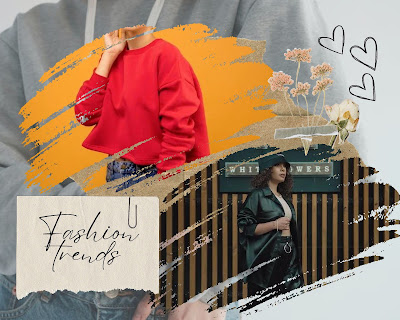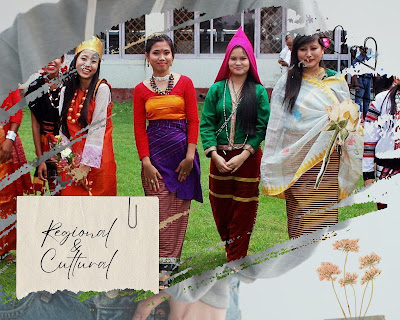Introduction:
A range of people,
including influencers, celebrities, and designers, set fashion trends. Social
movements and cultural trends also have an impact on them. Following trends can
be advantageous since they can serve as a source of inspiration for our own
unique styles and keep us up to date and relevant in both our social and
professional life. But it's crucial to keep in mind that not everyone can pull
off a trend, and in the end, our clothing choices should mostly depend on our
own sense of comfort and style.
It's crucial to take the fashion industry's environmental and ethical issues into account. Being picky about the trends we choose to follow and making sure they fit with our own beliefs and tastes is a smart idea. In the end, we should base our decision about whether or not to follow trends on what makes us feel confident and at ease.
Street Style and High Fashion
These two categories are the primary places where fashion trends start. The term "high fashion" describes the upscale and designer labels that, through their runway presentations and annual collections, establish the standard for the sector.
 |
| Street Style and High Fashion |
Conversely, street style refers to fashion trends that naturally arise from the decisions made by regular people when out and about, as promoted by street photographers and influencers. The interaction between street style and haute fashion frequently shapes the direction of trends.
Fashion Trends
Here are some more specifics on fashion trends, including when and why to follow them:
 |
| Fashion trends |
Impact of Fashion Designers: Trends are mostly determined by the work of fashion designers. They design collections that feature fresh silhouettes, colors, and textiles. Their designs are frequently on display at fashion events and exhibits, garnering media coverage and impacting the fashion industry at large.
Influencers and celebrities: Influencers and celebrities have a big say in what fashion trends are. Fans closely observe and broadcast their fashion decisions, which boosts the appeal of particular looks. A popular person's attire or endorsement of a particular brand might spark a trend very rapidly.
Cultural and Social Movements: Cultural and social movements have an impact on fashion trends as well. For instance, specific fashion trends may appear as a response to social issues or as a means of self-expression. These patterns can serve as a means for people to express their connections or opinions as well as a reflection of broader cultural changes.
Benefits of Following Trends: There are a number of benefits to keeping up with current fashion trends. It lets you broaden your wardrobe repertoire and try out fresh looks. It helps you stay up to date and relevant by keeping you informed about the most recent advancements in the fashion business. Adhering to trends can also give you a sense of identity and connection to the greater fashion world.
Comfort and Personal Style: Although trends can be thrilling, it's vital to keep in mind that they might not always match your preferences for comfort or style. When choosing whether or not to follow a trend, it's critical to put your comfort, body type, and personal preferences first. Individuality should be reflected in your personal style, therefore feel free to adopt trends in a way that appeals to you or only in certain situations.
Ethical and Sustainable Aspects: Fast fashion and unsustainable consumption habits can
occasionally be sustained by fashion trends. It's critical to consider the
ethical and environmental ramifications of adopting trends. Make sustainable
fashion choices by looking into buying from ethical manufacturers, investing in
classic pieces, or looking into vintage or secondhand clothing.
Additional Insights On Fashion Trends
Here are some more details regarding fashion trends and their effects:
Trend Forecasting: The area of fashion trend forecasting is devoted to making predictions about next fashion trends. To predict future trends, trend forecasters examine a range of sources, including fashion shows, street style, consumer behavior, cultural influences, and world events. Their perceptions assist customers, retailers, and designers in remaining ahead of the curve.
Adoption Cycle of Trends: Trends in fashion usually go through an adoption cycle. Early adopters are those who are willing to try new fashions and are fashion-forward. Trends ultimately spread more widely and into the broad market as they gain traction. As the cycle comes to a finish, certain tendencies can begin to fade while others start to develop. Knowing this cycle will enable you to recognize when a trend is at its zenith or coming to an end.
Subcultures and Counter-Cultures: These groups are frequently the source of fashion trends. These communities create their distinct looks as a means of expressing themselves and defying prevailing trends in fashion. These subcultural styles may eventually find their way into the mainstream, spreading trends.
Economic and Social variables: Both social and economic variables have an impact on fashion trends. Consumer preferences and spending patterns can be influenced by economic conditions, including recessions and prosperous times. Through their impact on society values and aesthetics, social variables such as technological advancements, cultural diversity, and gender role changes also influence fashion trends.
Globalization and Digital Influence: The emergence of digital platforms and globalization have had a significant impact on fashion trends. Trends can travel quickly across national boundaries when there is fast access to global fashion content. Due to the fact that celebrities, fashion bloggers, and influencers use social media platforms like Instagram and TikTok to share their looks and advice with enormous audiences, these platforms have become important in setting trends.
Fashion's Significance in Identity and Expression: The ways in which we express our identities are greatly influenced by fashion trends. They enable us to share our individual preferences, morals, and connections. Adhering to trends can be interpreted as an indication of cultural capital or as a means of indicating group membership. On the other hand, some people could decide to embrace originality and reject trends by developing their own distinctive styles.
Fashion as a Creative and Artistic Outlet: Trends in fashion highlight the industry's creative and
artistic elements. They showcase the creative ideas, skill, and exploration of
fashion designers. Fashion is an exciting medium for creativity and
self-expression since trends frequently push limits and challenge established
conventions.
Personalization and originality
Although trends serve as a source of inspiration, it is still crucial to show originality through one's own sense of style. Fashion trends ought to be a springboard for personal expression, enabling people to mix and match, experiment, and customize trends to suit their own tastes. Through do-it-yourself projects or distinctive styling decisions, personalization and customisation can enhance trends and give them a more distinctive feel.
Regional & Cultural Fashion
Depending on these factors, fashion trends might differ greatly. Every location has its own center of fashion as well as distinct fashion tastes. Fashion trends can also be influenced by historical allusions, cultural customs, and regional aesthetics. It's amazing to see how regional cultural influences meld with international fashions to create distinctive and varied fashion interpretations.
Conclusion
In conclusion, keeping up with current fashion trends may be an exciting and inventive approach to try out new looks. Prioritizing your comfort, morals, and sense of personal style is crucial, though. When embracing trends, choose carefully and according to your own honest and self-assured feelings, keeping in mind the ethical and sustainable components of the fashion industry.


.png)


0 Comments